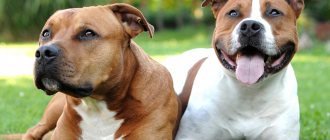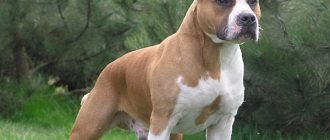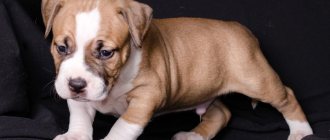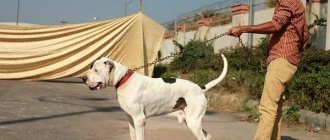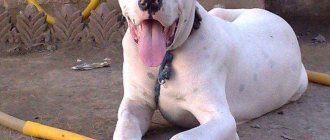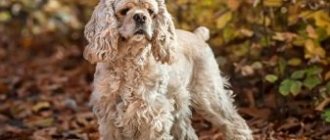Description of breeds
Amstaff and pit bull are different subspecies of the same breed. The ancestors of the dogs were the English bulldog and terrier. Despite the fact that the main selection was carried out in America, the homeland of the animals is England.
The breed was first developed by poor landowners. Since the law prohibited them from having large baiting dogs, they selected small individuals for protection and hunting.
Later, pits began to be used in dog fighting. But since 1835, the House of Commons of the United Kingdom has banned cruelty to animals. But the American government was more loyal to bloody games. Here the first individuals were bred, similar to modern Amstaffs and pit bulls.
Selection was carried out in two directions - working and exterior. This is the key difference between pits and staffs. When breeding the former, the emphasis was on working qualities, while for the latter, on appearance.
Key moments in the history of the breed:
- 1870 – dogs were brought to America;
- 1921 – the pit bull terrier club was founded, full-fledged breeding work began;
- 1936 – official recognition of the Staffordshire Terrier breed;
- 1972 - the dogs were given a different name - American Staffordshire Terrier.
The FCI standard allows only one variety - Amstaff. The Pit Bull Terrier is recognized by the ADBA and UKC, the organizations that register pit bulls.
This nuance should be taken into account when choosing a puppy. Pit bulls do not participate in official exhibitions or competitions.
Differences in appearance
The dogs are medium-sized, powerful, strong. They are the embodiment of strength. At the same time, not large, but lean.
The main sign of how to distinguish an Amstaff and a pit bull is physique. In the former it is more proportional, while in the latter there are slight disproportions. Pitas have short legs, a large head and a back with a “dome” top.
Despite the less proportional body, the American Pit Bull Terrier is tougher than the Amstaff. He can last in battle for up to 3 hours.
A closer comparison reveals some differences between the dogs in appearance.
General parameters: height, weight
| Amstaff(FCI) | Pitbull (ADBA, UKC) | |
| Height | 44 – 48 cm – females, 46 – 50 cm – males. | 37 – 40 cm – females, 40 – 42 cm – males. |
| Weight | 22 – 25 kg – females, 25 – 30 kg – males. | 13.6 – 22.7 kg – females, 15.9 – 27.2 kg – males. |
Wool, color
The breeds are largely similar in coat and color.
| Amstaff (FCI) | Pitbull (ADBA, UKC) | |
| Wool | Short, shiny, close to the body. | Same requirements. |
| Color | Any color is possible, plain or spotted. The exception is white, liver, black and tan. Light spots occupying more than 80% are also considered a defect. | Any, with the exception of merle and albinism - they talk about health problems. |
Physique, body
Amstaffs have a powerful, deep chest, not barrel-shaped. The paws are set tightly to the body. There is a slight slope from the withers to the croup, and from the latter to the tail.
Pit bulls have a fairly wide chest, not cylindrical or round in shape. Medium lumbar length.
Head, jaw
The Amstaff's head is smaller than that of a pit bull and is proportional to the body. The jaw is inferior in size and power to pits; the bite should be scissor-shaped.
The pit bull's head is wedge-shaped, large relative to the body, but harmonious. Most of the skull is occupied by the powerful zygomatic muscle.
Let's look at the differences between the eyes, ears and nose of representatives of these breeds in the table below.
| Amstaff (FCI) | Pitbull (ADBA, UKC) | |
| Nose | The lobe is painted only black. | All shades that harmonize with the main color are allowed. |
| Ears | Fully or semi-erect, less than a pit bull terrier, undocked preferred. | Set high, docking is allowed. |
| Eyes | Wide and low set, round, dark in color. Amstaffs with blue eyes and pink eyelids are considered marriageable. | Same parameters. |
Differences in Personality
Amstaffs and pit bull terriers have gained fame as merciless killers. The explanation lies in the original purpose - the breeds were bred for fighting. Particular cruelty is attributed to pit bulls. They are still banned in some European countries and US states, and their content is subject to strict rules and prohibitions.
Today both breeds are companion dogs. They are affectionate, playful and endlessly devoted to their owner. However, only an experienced owner can handle them.
The reputation of aggressive dogs is partly supported by their owners. They unintentionally, due to lack of experience, or deliberately develop cruelty in their pets. As a result, animals grow up uncontrollable.
The standard attributes confidence to both breeds. Cowardice or unreasonable aggression is not allowed.
When deciding who to choose, an Amstaff or a pit bull, take into account the following nuances:
- Staffordshire Terriers are more flexible, they remember commands more easily and are more willing to carry them out;
- It is believed that the level of aggression in pit bulls is higher;
- both breeds are among the smartest, but Staffs are more diligent “students”, as they try to please the owner;
- Contrary to popular belief, both dogs cannot be used for guarding, they are only suitable for protection.
How much does a dog cost?
The price of a puppy is influenced by the status of the animal and the place where it was purchased. A baby purchased at the poultry market at your own risk will not cost much. Its price is about 5 thousand rubles. But at the same time, you will never receive any guarantees regarding the purity of the dog’s breed and its health.
If animals with poor genetics were used during the mating process, the babies will have many negative qualities. And if these qualities can still be forgiven for decorative breeds, then in the case of staff terriers it is better not to take risks.
A puppy from a kennel will cost more: from 8 to 20 thousand rubles. But this baby has all the necessary documents and first vaccinations.
Photo: https://pixabay.com/photos/puppy-dog-staffy-doggy-pup-brown-2298836/
The cubs of titled champion parents have the highest price. Its price can reach 60 thousand rubles.
Care and education
There are no differences in care and training between a pit bull and an amstaff.
Both dogs can be kept in a house or apartment provided there is sufficient exercise. An American Staffordshire Terrier or Pit Bull should not be kept on a chain. Because of this, the animal will develop aggression and have problems with territorial behavior.
Dogs tend to be dominant. They are recommended to be owned only by experienced owners.
Education should be strict, but not cruel. It is built on the basis of trust, rewards and punishments. Classes with a dog handler are shown.
Dog care includes:
- at least two walks a day for 1 hour;
- bathing once a month;
- daily brushing;
- trimming nails as they grow;
- rubbing the eyes and ears with a special solution once a week.
What is the difference?
External differences:
- If we talk about average parameters, then Amstaff is six centimeters taller,
- he has longer legs,
- the pit bull is also inferior in the massiveness of the chest,
- Amstaff also has longer limbs,
- an important difference can be found in the shape of the jaw; in Staffords it is square and looks more powerful,
- In Belterriers, the tip of the nose can be pigmented not only black.
As for the differences in character and training, professionals say that the Pitbull is much tougher and more aggressive. Although it cannot be said that Staffords are completely devoid of aggression. They were bred precisely to amaze the public with their endurance and aggressiveness. But let’s not forget that they were recognized by the International Canine Federation and are bred without special control in various countries of the world, while Bull Terriers are banned or closely controlled, and they have never been able to receive international recognition.
Attitude towards other animals and children
Pit bulls and amstaffs treat children kindly, even with adoration. They forgive all pranks and will protect the child, risking their own lives. Dogs enjoy playing with kids.
However, the animals are powerful, active, and can accidentally hit the baby while playing. Therefore, choosing a breed is preferable when the child reaches school age. If there are no children in the family, the dogs must be introduced to them.
Dogs perceive other pets as prey. Dogs can be trained not to touch “their” animals living in the same territory. But during a walk, they carefully monitor that the amstaff or pit bull does not chase a cat, bird, or squirrel.
It is believed that the Amstaff gets along better with other pets than the pit bull. This is wrong. Both representatives have a pronounced hunting instinct. They will only be calm about pets they grew up with.
It is impossible to say for sure who is better, an amstaff or a pit bull.
The choice often comes down to personal preference. The breeds have similar personalities; with proper training, both dogs will grow up to be calm and devoted companions. But if the owner wants the dog to participate in exhibitions, he will have to get a Staffordshire Terrier. Source
Characteristics of the American Staffordshire Terrier
| Attachment level | High |
| Friendliness | High |
| Child Friendly | Average |
| Loyalty to other pets | Average |
| Exercise needs | High |
| Playfulness | High |
| Energy level | High |
| Learning ability | High |
| Intelligence | Average |
| Tendency to bark | Average |
| Shedding amount | Average |
Characters
The Staffordshire Bull Terrier is the friendliest dog of this three breeds, both to its relatives and to people. Although it has strong jaws, it is quite capable of repelling an offender. The subspecies has long been used exclusively as a companion and exhibition exhibitor; aggressive individuals are excluded from breeding. The Staff Bull is friendly and sociable, loves his family.
Friendly dog
Staff and pit bull, also long forgotten their fighting past, are today used as companions, in canine sports or in police service. Both breeds, with proper socialization and upbringing, are absolutely safe for society and are excellent to train. AST and APBT are very active, mobile and attached to humans. They have the tenacity typical of a terrier and can be used as rescue dogs, detection dogs or bodyguards.
For your information: In the USA, the American Staffordshire Terrier is ahead of Labradors in canistherapy, contrary to stereotypes about the killer dog. Although it is worth noting, the breed population in the States is mentally different from the European one.
What is the difference between a pit bull and a Staffordshire terrier is a difficult question, due to the striking similarity of the subspecies. But there is a difference - the pit bull is more impulsive, impatient, more aggressive, and if it fights, it will be to the death. Pete needs not a cruel, but a firm hand from his owner, even more firm and stubborn than a dog. Without proper training and early socialization, APBT can be truly dangerous.
How to choose a puppy
- A normally developing Staffordshire Bull Terrier puppy should be playful, curious and very active (the animals become calmer with age). If the baby is too phlegmatic and thoughtful, there is clearly something wrong with him.
- If a small staff bull does not make contact, becomes hysterical and tries to hide, this signals an unstable psyche. Usually, before purchasing puppies, they undergo the Campbell test, which helps determine the individual character traits of each baby.
- Males and females of the Staffordshire Bull Terrier differ both in appearance and in character. If the aesthetic characteristics of a puppy play an important role for you, it is better to choose doggies. They are larger, stronger and generally have more pronounced breed characteristics. Staffy bull females are suitable for those owners who need a more manageable pet. “Girls” are more strongly attached to the family, they are more temperamental, are not prone to leadership and are easier to train.
- Carefully inspect the nursery and the puppies' habitats. Babies and their parents should not live in cramped, dirty cages.
- Ask the breeder or nursery staff for the results of testing the litter for genetic diseases. If there are no certificates, the seller is most likely inexperienced and is engaged in breeding solely for personal enrichment.
Useful materials:
- Cutaneous horn General description of the disease Cutaneous horn on the forehead or face (ICD 10 code - L57.0) -...
- Itching and odorless discharge Main causesBefore considering the factors that provoke the appearance of discharge that has a sour odor, it is necessary to immediately note...
- Normal temperature in animals Normal temperature in different types of animals Veterinary services Day hospital for animals Veterinary certificates Vaccination…
- Discharge in women What kind of discharge between menstruation is considered normal? Female discharge normally consists of mucus from the cervical canal, dead...
Living conditions, education and training
When it comes to living conditions and training, there is no difference between the Pit Bull Terrier and the Staffordshire Terrier. Both breeds require high levels of socialization with people and animals to avoid mental problems or phobias.
Both species require disciplined training and long active walks. Cynological sports are recommended: canicross, frisbee dog, dogpulling. Excellent results can be achieved in waitpulling, springpole and even obedience.
Cute Staffbull
The Staff Bull, unlike the Pit Bull and Amstaff, is less stubborn, kind by nature, and needs gentle training. But by analogy with terriers, it requires a constant surge of physical energy and mental potential. Smart, tries to please the owner - easy to train.
None of the three breeds are suitable for living in an enclosure; short hair and a complete lack of undercoat will not be able to warm the dog in cold weather. All described species are very attached to their owners and require constant contact with humans. Due to the not very large size of the breed, keeping it in an apartment or house is acceptable, but subject to daily active walking.
Physical exercise
In the description of the Stafford dog breed, we said that it is a well-built, muscular animal. Therefore, physical activity is simply necessary for the dog to feel good and stay in shape. It tolerates long runs and cycling well.
When walking, the staff needs to throw balls and sticks or play with him differently so that he runs more. When choosing this breed for yourself, you must take into account that you need to walk him during the day and in the evening for one and a half to two hours.
Attitude towards children and other animals
The Staffordshire Bull Terrier is a very sociable breed. He gets along well with other animals, especially those he has known since childhood. He may be distrustful of strangers, but without aggression he is unsuitable for security work. Individuals actively participating in exhibitions are loyal to absolutely any stimuli.
The Staffordshire Terrier and Pit Bull can only be loyal to strangers if they have a high level of socialization. Open aggression is considered a vice, but protective instincts are at a good level, and therefore distrust of strangers is the norm. Pit bull terriers have a harder time socializing with other animals, but well-socialized, disciplined dogs can be very friendly.
Amstaffs and Staffbulls have a high pain threshold and a strong nervous system, unlike pit bulls, so they are safer for children. But you shouldn’t let your child get close to an unfamiliar dog without the owner’s permission. In addition, all three breeds have strong jaws that have a “death grip” and an ordinary game can end sadly. As a summary: very young children should not be left with such dogs.
Amstaff
Feeding
Pit bulls and Staffordshire terriers are absolutely not capricious when it comes to food: dog experts consider these breeds to be practically omnivorous.
A similar diet is recommended for Petes and Staffs. They can be fed both natural products from the table and high-quality industrial feed.
The diet must be balanced and include all the necessary vitamin complexes. The nutrition of pit bulls and Staffordshire terriers must correspond to the age of the pets and their state of health.
Pit bulls have allergic reactions to a number of foods.
Harmful to pitas are:
- beef;
- rice;
- corn;
- wheat.
In addition, pit bulls should not be “treated” to various cereals, unlike other dog breeds. Grains cause rapid obesity in pets.
The exception is puppies during their active growing up period.
Differences in walking and hygiene
There are no differences between the pit bull, staff bull and stafford regarding walking - all three breeds are very active and mobile. Without a splash of energy, they display destructive behavior at home: they chew things, bark for no reason, and jump on household members. Walks should include dynamic games and at least 2-3 hours a day.
Due to the similar type of constitution and coat, there are also no differences in hygienic care among breeds:
- Comb 1-2 times a week with a furminator or a comb with natural bristles, every other day during seasonal shedding.
- Wash 3 – 4 times a year – no more often.
- Once a week, wipe your eyes with a swab dipped in a special lotion.
- Clean the outer part of the ear with hygienic ear fluid 1 – 2 times a month.
- Trim the nails as they grow using a nail trimming guillotine, carefully so as not to damage the inner living part of the nail.
- Brush your teeth once every 2 weeks.
Teeth brushing should be done with a paste and brush designed for dogs.
Tips for choosing
It is impossible to say for sure who is better - pit bull, staff bull or stafford. It all depends on the purpose for which the pet is purchased. Each breed is good in its own way, but for a specific purpose.
Champion
The Staffordshire Bull Terrier is suitable for:
- exhibitions and breeding;
- families with small children;
- small-sized standard buildings;
- beginners in dog breeding;
- people with an active lifestyle.
The American Pit Bull Terrier is suitable for:
- security or search service;
- experienced dog breeders;
- keeping in an apartment or house;
- sports training;
- active people with a strong character.
The American Staffordshire Terrier is suitable for:
- exhibitions and breeding;
- sports training;
- police service or investigative work;
- keeping in an apartment or house;
- families with older children;
- people with an active lifestyle.
Before deciding on a breed, you need to clearly know why the dog is being bought, based primarily on the purpose of the dog, and not on aesthetics. Considering the minimum breed characteristics, it is not difficult to decide - the STBT is absolutely not suitable for security work, and it is not advisable to take the APBT into a family with very young children.
Reviews
Perhaps the following reviews from dog breeders will help you make the right decision.
To read: Labrador Retriever: characteristics of the breed and advantages of pets
Petr Mikhailovich Slavetsky, a breeder of Staffordshire terriers with 20 years of experience: “I have a lot of experience working with Amstaffs, but I couldn’t handle a pit bull terrier. They have a more assertive character. If you pit these two fighters against each other in the ring, I would bet on the pit bull.”
And this opinion from Alla Nikiforova from Novosibirsk: “All stereotypes were shattered when we got Jack, an American pit bull terrier. The only thing he is capable of is being a pet and being affectionate to all family members, but by nature he is simply a weakling. Even our cat manages to chase him. It is rightly said that the aggressiveness of our pets depends on our attitude towards them. Although you should not forget that this is a strong beast with powerful sharp jaws. His life depends on you and you have a great responsibility.”


